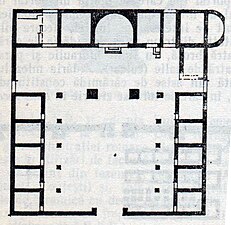History
The Drobeta Roman fort had at least five consecutive phases of construction and consolidation. The first phase began in 101 AD. The fort had a rectangular shape and was surrounded by a wall built in opus caementicium with facing opus vittatum . All four gates were flanked by two inner towers. The curtain wall was doubled on the inside and a defensive trench was dug on the outside. As appears on Trajan's Column, there were wooden constructions inside the castle but some remains of masonry belong to this stage, perhaps only the principia. [8]
In the second stage, of Hadrian's era, stone buildings included the praetorium (officers' residence), barracks, hospital (valetudinarium) and horrea . The praetorium and hospital had rooms arranged around a central space framed by porticoes.
The third phase is dated to Emperor Gallienus (r.260-8) after the destruction following the Carpic invasion in 245-247. Due to the change in military tactics and defense, three gates were closed: the decumana and two principales, and a large outer tower with a square plan was built in their place. The main praetoria gate was rebuilt flanked by two outer semicircular towers. The outer and corner towers were doubled with outer towers. The outer ditch was filled in and three other wider and much deeper ditches dug. The Principia were modified according to a basilica plan and everything was redesigned around a wide road while the barracks were reduced and modified. [9]
In the fourth phase repairs were made and the enclosure wall was modified following the withdrawal from Dacia during the time of Constantine the Great (306-337). Stone barracks were built and the intermediate spaces were rearranged making room for household workshops such as pottery kilns. Probably the old space of the headquarters of the military command was used as a garrison by federates of the Sântana de Mureș-Cerneahov Culture from the 4th century. [10]
The fort was destroyed in the first half of the 5th century probably by the Huns and the 5th phase from the end of the 5th century, possibly under Emperor Anastasius I, provided for the rebuilding of the enclosure wall. Barracks were built outside the fort arranged in four buildings and each barracks had a row of rooms with a portico on the front. Bread ovens, baths, pottery workshops and other facilities needed by the garrison were located in the blocks formed.
The last restoration of the castle dates to Justinian I (527-565) who partially restored the castle, when Drobeta had the last flourishing period and the fort was temporarily called "Theodora" (after his wife).
The fort was probably destroyed by the Avars at the beginning of the 7th century and a settlement was built over its ruins in the 10th century.
Phase 2 fort
principia, phase 2
Phase 5 fort
Baths
Romula or Malva was an ancient city in Roman Dacia, later the village of Reşca, Dobrosloveni Commune, Olt County, Romania. It was the capital of Dacia Malvensis, one of the three subdivisions of the province of Dacia.
Moskon was a Getic king who ruled in the 3rd century BC the northern parts of Dobruja, probably being the head of a local tribal union, which had close relations with the local Greek colonies and adopted the Greek style of administration.
Rubobostes was a Dacian king in Transylvania, during the 2nd century BC.
Zyraxes was a Getae king who ruled the northern part of what is today Dobrogea in the 1st century BC. He was mentioned in relation with the campaigns of Marcus Licinius Crassus. His capital, Genucla, was besieged by the Romans in 28 BC, but he managed to escape and flee to his Scythian allies.
Aelius Catus was a Roman commander near the Danube who, according to Strabo's geography, transplanted 50,000 Getae from what is now Muntenia in Romania far to the south of Danube, in Moesia.

Porolissum was an ancient Roman city in Dacia. Established as a military fort in 106 during Trajan's Dacian Wars, the city quickly grew through trade with the native Dacians and became the capital of the province Dacia Porolissensis in 124. The site is one of the largest and best-preserved archaeological sites in modern-day Romania. It is 8 km away from the modern city of Zalău, in Moigrad-Porolissum village, Mirsid Commune, Sălaj County.
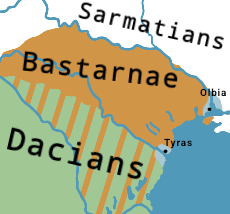
Oroles was a Dacian king during the first half of the 2nd century BC.

Trajan's First Dacian War took place from 101 to 102.
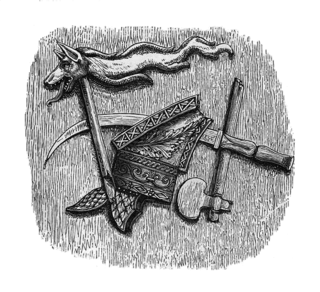
Comosicus was a Dacian king and high priest who lived in the 1st century BC. The only reference to Comosicus is a passage in the writings of the Roman historian Jordanes.
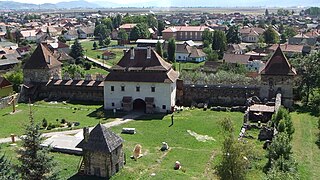
Lazar Castle, is a castle located in Lăzarea, Harghita County, Romania. The citadel is named after the Lázár de Szárhegy noble family and it is built in a combination of Romanesque, Gothic, and Renaissance styles. The oldest part of the building dates from 1532, while the rest was added in 1631–1632.

Argidava was a Dacian fortress town close to the Danube, inhabited and governed by the Albocense. Located in today's Vărădia, Caraș-Severin County, Romania.
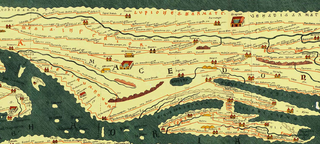
Amutria was a Dacian town close to the Danube and included in the Roman road network, after the conquest of Dacia.
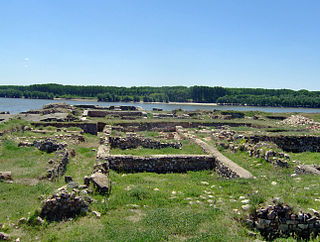
Capidava was originally an important Geto-Dacian centre on the right bank of the Danube. After the Roman conquest, it became a civil and military centre in the province of Moesia Inferior and part of the defensive frontier system of the Moesian Limes along the Danube.

Ad Mutriam was a fort in the Roman province of Dacia in the 2nd century AD.

Cumidava was a fort in the Roman province of Dacia Apulensis. It is located at 4 km (2.5 mi) northwest of the city Râșnov, Romania near the city of Vulcan. The site is located on the middle terrace of Bârsa River.
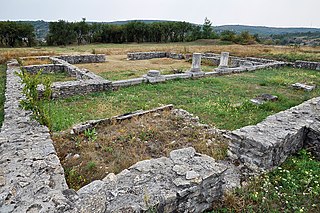
The castra of Buciumi was a fort in the Roman province of Dacia in the 2nd and 3rd centuries AD. Remains of the surrounding vicus were also unearthed. The castra's ruins are located in Buciumi, Romania.

The Castra of Călugăreni was a fort in the Roman province of Dacia located on the north-western periphery of the modern village of Călugăreni, Romania. The fort was built in the 2nd century AD and abandoned in the 3rd century. Archaeological research also proved the existence of a nearby canabae.
This section of the timeline of Romanian history concerns events from Late Neolithic until Late Antiquity, which took place in or are directly related with the territory of modern Romania.
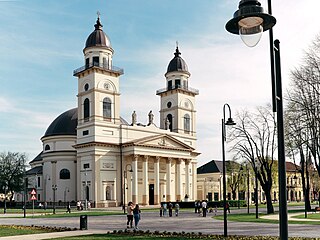
The Ascension Cathedral is the name given to a religious building belonging to the Catholic Church that serves as the cathedral church of the diocese of Satu Mare. It is located in the city of Satu Mare, in the northern part of Romania.
This page is based on this
Wikipedia article Text is available under the
CC BY-SA 4.0 license; additional terms may apply.
Images, videos and audio are available under their respective licenses.




